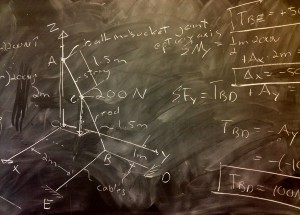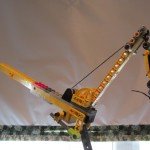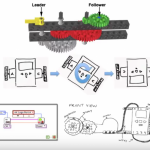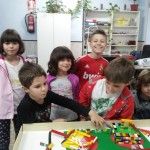 Although technology/engineering has been a part of the Massachusetts state curriculum frameworks since 2001, meaningful implementation has been slow for a number of reasons.
Although technology/engineering has been a part of the Massachusetts state curriculum frameworks since 2001, meaningful implementation has been slow for a number of reasons.
For example, technology/engineering is considered outside the purview of the liberal-arts. Science teachers are slow to accept technology/engineering as an additional part of their responsibility. There is no place in the school day or budget to add technology/engineering as a core academic subject. Technology/engineering is poorly understood, and has an unclear overlap with vocational education. The STEM subjects, in practice, are poorly integrated. Many schools lack specialized shop space. While several selective private schools have outstanding innovating technology/engineering programs, this raises issues of equity of access.
A group of Tufts professors are working with the Educational Development Center to make engineering education more accessible to K-12 Students, under the title of the Massachusetts Engineering Innovation and Dissemination Community (MEIDC). As part of this effort, we are surveying the current ‘landscape’ of K-12 engineering in Massachusetts. This article, and the related website, K-12 Engineering Education in Massachusetts are intended as part of this project.
Note: A somewhat similar essay was published in 2009 by Jacob Foster of the Massachusetts Department of Education.
Engineering and technology – not part of liberal arts?
Engineering and technology have traditionally not been considered part of the liberal arts curriculum in American public school programs. (The current high school liberal-arts curriculum was largely set up in 1893 by the Committee of Ten.)
In Massachusetts middle schools, while it has been part of the science framework since 2002, technology/engineering is most often offered as an arts-elective, a hold-over from its previous existence as industrial arts. In college-prep high schools, most students fulfill their science MCAS requirement with physics or biology. Engineering and technology offerings, if they exist, are not considered core science courses, and are offered as optional electives. Often at best there are only one or two electives in engineering fields, plus a few computer science offerings.
Engineering and technology – not part of science
While the natural sciences are part of liberal arts, engineering and technology are not. For science teachers, engineering is seen as outside of their subject area, and not part of what they do; very few science teachers have any formal engineering education.
Teachers who do have an engineering background most commonly teach mathematics and/or computer science, as these areas offer greater employment prospects and an opportunity to apply their mathematics skills. Teachers are under close scrutiny for their students to achieve high outcomes on MCAS, SAT, AP and other standardized exams. Student test scores are an important part of teacher evaluation.
Although engineering design projects often are highly engaging to students, there is widespread fear that time spent on such projects will detract from coverage of required topics. As a result, project-based learning approaches are largely reserved for private schools or senior-year electives, where they are not part of high-stakes testing.
No STEM Integration
STEM (science, technology, engineering, and mathematics) is a misnomer; often there is little, if any, overlap between science, technology, engineering, and mathematics. Engineering is not well integrated into mathematics and science – so where are teachers supposed to have room in their day to fit it in?
Although college introductory engineering courses typically require calculus and differential equations, most middle and high school engineering courses require little more than simple algebra, leading to a perception of these courses as not being equal in rigor to mathematics and science courses at the same grade level. Technology/Engineering courses do not fulfill the science requirements for graduation in many high schools. College engineering programs emphasize the importance of strong science and math preparation in high school.
Engineering confused with vocational education
Students, parents, and most teachers have an unclear understanding of what engineering means. Due both to its implementation in middle schools as an arts elective, and the relative strength of engineering and technology programs in many vocational-technical high schools, it is often confused with vocational education. Even for students who express a strong interest in technology in middle school, parents of students in more affluent communities push them to attend academic liberal arts programs. (See “Lessons from History: Industrial Arts/Technology Education as a Case Study“.)
The current (2006) Massachusetts state technology/engineering framework is based on industries and technologies (communications, construction, transportation, etc.) rather than fields of engineering (mechanical, civil, electrical, chemical). This has been modified somewhat in the new draft standard slated for implementation in 2015, which places a greater emphasis on engineering systems, and design projects which illustrate science concepts, and less emphasis on technology.
The Next Generation Science Standards (NGSS) also de-emphasize technology. Whether this is a positive change is debatable. Making things is a fundamental human activity, and has always attracted students to technical fields. (See “Made With Code” video.)
Teacher isolation
While there have been numerous curriculum development projects (many NSF- funded), and various professional development opportunities, the most effective professional development stems from seeing what other teachers are doing in the classroom. However, this is often very difficult. Even if within driving distance, this requires release time and the hiring of substitutes, which many districts do not support. Isolation is a particular problem for teachers of technology and engineering, as they are often the only teacher of this subject in a given school.
Challenges in online education
Most K-12 engineering and technology curricula have limited open on-line documentation or open courseware, and many K12 educators have reservations about posting content online. This is due both to privacy issues as well as the time-consuming nature of creating online course materials. There is a perception that if teachers implement a ‘flipped classroom’ model, with lecture material presented online, that students will not view the materials. In addition, the creation of effective online curriculum material is often very labor-intensive, as well as being technically difficult for novices.
Lack of space, equipment, and supplies
In Massachusetts, most public schools no longer have shop spaces (many were abandoned in the 1980’s and 1990’s as obsolete, expensive, and dangerous. While the rise of the ‘maker movement’ and ‘maker spaces’, featuring less hazardous, digital tools has begun to reverse this trend, this is still in its infancy, and is most common in small private schools.
Summary of challenges
- How can engineering become accepted as a core subject in a liberal arts program?
- How do we educate math and science teachers to teach engineering concepts?
- How can teachers better share and exchange best practices in curriculum and pedagogy, and reduce academic isolation?
- How can we communicate a clearer understanding to students, parents, and teachers what engineering is, and why it matters?
- How can project-based, open-ended learning be implemented in public schools?
- How can science, technology, engineering and math education be better integrated?
- How do we attract under-represented groups (women, minorities, poor) to engineering and technology- perceived as white, male preserves?
- How can we improve equity in access of all students-including those in rural/smaller schools- to quality engineering instruction?
This article is intended as part 1 of 2. Part 2 looks at opportunities and positive developments (view a draft here).
Jonathan Dietz
Latest posts by Jonathan Dietz (see all)
- Challenges in K-12 engineering education: Lessons from Massachusetts - 18 January 2015
- What is the difference between engineering and technology? - 18 November 2014
- What is technology? - 11 November 2014
- What is engineering? - 6 November 2014
- Learning Dimensions: Another way to assess - 6 November 2014


